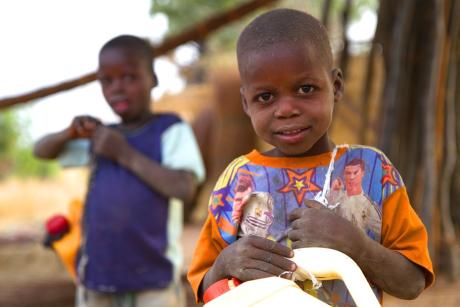
Bolun Li with his team members in Samlout district, Battambang province of Cambodia
Published October 29, 2015, last updated on October 12, 2017 under Voices of DGHI
By Bolun Li, second year MSc-GH student
After studying for a year at Duke Global Health Institute (DGHI), my research project brought me back to Southeast Asia. With generous support from DGHI, the SNV Netherlands Developing Organisation (SNV) and the Maddox Jolie-Pitt Foundation (MJP), I carried out an environmental health research project to examine the health impacts of clean cook stoves and fuels in Samlout district, Battambang province of Cambodia.
Meeting my Fieldwork Partners
After carefully developing my research plan and preparing for the logistics, I landed in Phnom Penh on a sunny afternoon. My work started with visiting our first partner organization, the Cambodian office of SNV. SNV is one of the leading international NGOs in renewable energy, water sanitation and agriculture. Since clean cook stoves and fuels are part of the mandates of SNV in renewable energy, I worked very closely with the renewable energy team to discuss details in logistics and budgets.
I was then introduced to my second partner organization, the Maddox Jolie-Pitt Foundation. Established by Angelina Jolie and Stephan Bognar in 2003, MJP’s headquarters are in the remote rural area in Samlout, Battambang province of Cambodia. Before MJP was established, there were no health centers, no schools, no roads and no electricity in the area. 80 percent of the households performed open burning, and prevalence of malaria, tuberculosis and other infectious diseases were extremely high.
With the efforts of MJP over the past decade, six health centers have been established in six villages, schools for children and farmers are built up and being operated, electricity generation is possible with control of flow, and rural roads have been built. Open burning has been brought down by 40 percent, and incidence of infectious diseases has decreased as well. Even though there is still no waste management system due to limited capacity, MJP has been making every effort so far and initiatives will hopefully come out very soon.
Adding Value to the Work of the Maddox Jolie-Pitt Foundation
You see how blessed I was working with such terrific organizations. Development work is always easier said than done, especially when there is no existing capacity. In this situation, my research project is also special for MJP, since there is a significant lack of data to inform their interventions.
For example, the health team at MJP has been working on fighting against respiratory diseases in the villages, and one of the messages they want to deliver to the community is that cooking with traditional stoves with children nearby will create huge negative impacts on health of the children. But because of the lack of data and research, the statement is not strong enough to convince household members. If our research on cook stoves clearly shows the correlation between staying by traditional stoves and children’s health, their message for intervention will be much clearer, and they can integrate it into their educational sessions with the household members.
My Work on the Ground
So I started to recruit team members, design training sessions and carry out household surveys together with my team. Ten members were divided into four teams to conduct household surveys in six villages in Samlout, and at the same time we took health measurements, including height, weight, blood pressure, pulse rate, blood oxygen level, MUAC (mid upper arm circumference) and lung functions.
In addition, we also measured stove usage with Stove Use Monitors (SUMs) and indoor air pollution with PM monitors. Eventually we collected 372 household surveys in five weeks, with a total number of 1,525 individuals.
Survey Says …
So far, we have some preliminary results on the health status of households based on our data, and some of the results are astonishing:
- Almost half of the participants for spirometry (lung function) reported having contraindications (problems that make them not qualified for lung test), and regular chest pains, fever or new cough and surgeries are the most important reasons for contraindications.
- 73 percent of respondents reported occasional abdominal pain, and 42 percent reported occasional nausea, as well as 28 percent chronic cough.
- Even though the rate of infectious diseases has decreased, 3.9 percent participants reported having malaria and 2.5 percent reported having tuberculosis.
We are still working on a more comprehensive analysis of the data, which will include both descriptive analysis and regression analysis. I hope the report will eventually help MJP yield positive health impacts through its future health and social economic interventions. By that time, I will be glad to climb on the hills in Samlout with my old friends and proudly say that my journey in Cambodia was such a success that people’s lives have been significantly changed because of our collective efforts.
Please allow me to thank my whole team in Cambodia, without whose support it is not possible to achieve where we are now.


